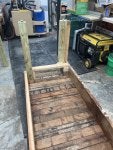I’m rebuilding my workbench which is longer than a 8’, 3/4 MDF TOP.
the bench is around 14’ long.
instead of a butt joint placing the MDF end to end what about a lock joint of some kind. I think I have a lock joint bit from
Infinity Tools but I think it’s just for connecting boards perpendicular to each other.
What would you do with this joint?
Suggestions please.
I'm still a ways from working on the top.
the bench is around 14’ long.
instead of a butt joint placing the MDF end to end what about a lock joint of some kind. I think I have a lock joint bit from
Infinity Tools but I think it’s just for connecting boards perpendicular to each other.
What would you do with this joint?
Suggestions please.
I'm still a ways from working on the top.














